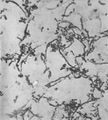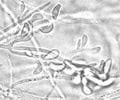Search results
From MicrobeWiki, the student-edited microbiology resource
Page title matches

File:Bacilli P7060990 (2).jpg (714 × 579 (139 KB)) - 21:19, 2 May 2015
File:R. dentocariosa-cocci and bacilli forms.jpg (328 × 364 (47 KB)) - 01:12, 23 September 2016
Page text matches

File:Capent.jpg Note colorless capsules surrounding purple bacilli.(311 × 235 (56 KB)) - 04:57, 29 August 2007
File:02-0485 1b.jpg ...l-Neelsen stain of the same nodule, showing abundant colonies of acid-fast bacilli in the necrotic subcutaneous tissues (original magnification 100x).(600 × 428 (58 KB)) - 01:59, 27 August 2009
File:20101017 175758 Bacilli.jpg Some Gram-positive bacilli, presumably of the genus <i>[[Bacillus]]</i>.<br/>(300 × 251 (17 KB)) - 00:55, 2 May 2012- Class: Bacilli1 KB (226 words) - 14:07, 22 February 2011
- Domain: Bacteria; Phylum: Bacillota; Class: Bacilli; Order: Bacillales; family: Staphylococcaceae [Others may be used. Use [ht2 KB (222 words) - 22:39, 20 December 2022
- ...mission electron microscopes. The bacteria was found to be a gram-negative bacilli. Genome sequencing was analyzed using 16S rRNA. Findings showed the bacteri Pseudoxanthomonas winnipegensis is gram-negative bacilli with a yellowish pigment. Additionally, research has found they are aerobes4 KB (580 words) - 22:36, 13 December 2022
- <I>Prevotella micans</I> is a gram-negative bacilli that is primarily an obligate anaerobe. The species was isolated from necro <I>Prevotella micans</I> is a non-motile, gram-negative bacilli. Cell size measures 1.5-5μm long by 0.7μm wide, and are normally arra4 KB (627 words) - 15:45, 22 February 2016
- ...e diameter had increased to 1.8–2.2 mm (4). The gram-negative bacteria are bacilli or circular shaped that consist of a high convex to pyramidal, with an off- ...a Fusca and Prevotella Scopos are anaerobic, non-motile, and gram-negative bacilli (4). The phylogenetic analysis of the 16Sr RNA gene sequence showed that st6 KB (912 words) - 01:33, 13 March 2014
- Bacteria; Bacillota; Bacilli; Bacillales; Alicyclobacillaceae; Alicyclobacillus; A. ''acidoterrestris'' A. ''acidoterrestris'' is an aerobic, gram positive, thermoacidophilic bacilli that produces endospores. It can survive in acidic environments down to 2.55 KB (724 words) - 16:28, 19 April 2022
- Bacteria; Firmicutes; Bacilli; Bacillales; Bacillaceae; Bacillus3 KB (340 words) - 20:53, 22 October 2015
- Domain: Bacteria, Phylum: Firmicutes, Class: Bacilli, Genus: Exiguobacterium, Species: Unknown2 KB (328 words) - 20:45, 30 October 2015
- Class: Bacilli2 KB (333 words) - 18:25, 25 August 2020
- ...dominantly Gram-negative cocci, with a few particularly long Gram-negative bacilli.<br/>Numbered ticks are 11 µM apart.<br/>Photograph by [[User:Blayloc3 KB (442 words) - 14:37, 28 September 2015
- Bacteria; Firmicutes; Bacilli; Bacillales; Bacillaceae; Amphibacillus ...o their natural environment. Before the isolation of ''A. fermentum'', all bacilli isolated from alkaline lakes have been obligate aerobes [[#References|[2]]]12 KB (1,565 words) - 04:34, 27 December 2012
- Bacteria; Firmicutes; Bacilli; Bacillales; Staphylococcaceae; Staphylococcus3 KB (328 words) - 20:50, 22 October 2015
- *Class:Bacilli <br />3 KB (362 words) - 19:36, 6 May 2016
- ...of a microscope. Comes in various different shapes, spheres (cocci), rods (bacilli), and spirals. But, the color depends on the specific strain and conditions3 KB (471 words) - 02:54, 13 December 2023
- Bacteria; Firmicutes; Bacilli; Bacillales; Bacillaceae; <i>Bacillus</i>; <i>Bacillus megaterium</i>3 KB (484 words) - 15:16, 29 September 2015
- Domain:Bacteria; Phylum: Firmicutes; Class:Bacilli; Order: Bacillasles; Family: Bacillaceae; Genus:Bacillus; Species: Bacillus ...that is for bacteria, and is designed to isolate Gram-negative and enteric bacilli on whether or not they could ferment lactose) was possible. Because of it s9 KB (1,316 words) - 15:10, 22 February 2016
- ...pe and size based on the environment. In this case, both the gram negative bacilli and gram variable staining diplococcic were present in the smear [2]. On bl ...ter pneumosintes gen. nov., comb. nov., nom. rev., Anaerobic gram-negative bacilli from the human gingival crevice. Int J Syst Bacteriol. 1994;44:187–92.]6 KB (908 words) - 20:03, 11 December 2015
- <i>Pseudomonas aeruginosa</i> is a gram-negative species of bacilli shaped bacteria. The genome consists of a rather large, single circular chr3 KB (521 words) - 15:51, 23 February 2024
- V. fischeri is a gram- negative bacilli bacterium. It is found in marine environments all over the world. It conta3 KB (461 words) - 15:13, 29 September 2015
- Domain/Superkingdom/Kingdom: Bacteria; Phylum: Firmicutes; Class: Bacilli; Order: Bacillales; Family: Bacillaceae3 KB (430 words) - 20:25, 9 April 2018
- Higher Order Taxa: Bacteria; Firmicutes; Bacilli; Bacillales; Bacillaceae, Bacillus3 KB (403 words) - 13:31, 6 September 2017
- Domain: Bacteria; Phylum: Firmicutes; Class: Bacilli; Order Bacillales; Family: Bacillaceae; Genus Bacillus; Species: Bacillus P3 KB (456 words) - 14:12, 2 April 2020
- ...undimonas diminuta'' is non-lactose-fermenting environmental Gram-negative bacilli [[#References | [1]]] . ''B. diminuta'' and ''Brevundimonas vesicularis''4 KB (444 words) - 00:02, 30 July 2013
- This gram negative bacilli bacteria has been successfully cultured using a trypticase soy agar plate w ...990. DNA homologies shared among E. corrodens isolates and other corroding bacilli from the oral cavity. Journal of Periodontal Research 25:106-112.]9 KB (1,268 words) - 00:55, 23 September 2016
- Bacteria; Firmicutes; Bacilli; Bacillales; Staphylococcaceae;3 KB (491 words) - 20:06, 26 August 2010
- Kingdom- Bacteria; Phylum- Firmicutes; Class- Bacilli; Order- Bacillales; Family- Bacillaceae; Genus- Bacillus; Species- Bacillus ...., Liu, Y., and Chen,S. "''Isolation and identification of nitrogen-fixing bacilli from plant rhizospheres in Beijing region". ''Journal of Applied Microbiolo7 KB (940 words) - 17:13, 4 December 2015
- <i>Kingella oralis</i> is a gram-negative, bacilli bacteria that was first observed by Chen et al in 1989, who were investigat <i>K. oralis</i> is a gram negative, bacilli(rod)- shaped bacteria that consists of the usual cell was structure of plas9 KB (1,289 words) - 05:56, 22 September 2016
- Bacteria, Bacillota, Bacilli, Bacillales, Staphylococcaceae, Gemella, <i> G. palaticanis</i>4 KB (565 words) - 21:42, 12 December 2022
- Domain; Bacteria. Phylum; Firmicutes. Class; Bacilli. Order; Bacillales. family; Bacillaceae3 KB (513 words) - 22:09, 3 December 2023
- Class: Bacilli ...constituents, the <i>B. pumilus</i> life cycle is similar to that of other Bacilli. It assumes any of three life stages: sporangium, vegetative cell, or free10 KB (1,472 words) - 22:17, 26 April 2012
- ...eat these bacteria and within the first three hours of being digested, the bacilli degrade the anterior pharyngeal chitinous ling and enter the body cavity an4 KB (495 words) - 00:17, 13 December 2023
- ...ssed by blood from infected animals. He also created pure cultures of the bacilli and showed that this also caused disease. [[#References|[12]]]These experim Class: Bacilli13 KB (1,957 words) - 20:56, 10 February 2016
- Class: Bacilli;4 KB (574 words) - 02:18, 11 December 2015
- ...ttp://www.buddycom.com/bacteria/gnr/gnrnogluc.html Bacteria, gram negative bacilli].5 KB (725 words) - 14:56, 6 October 2012
- Class: Bacilli ...ns and closely related to the widely studied ''B. subtilis''. Unlike other bacilli which are predominately aerobic, ''B. licheniformis'' is a facultative anae9 KB (1,206 words) - 17:43, 4 December 2015
- Class: Bacilli4 KB (550 words) - 15:06, 22 February 2016
- B. coprophilus cells are bacilli shaped with 0.7-0.8x2.5-4.1μm in dimension.4 KB (456 words) - 18:17, 3 May 2012
- Class: Bacilli C. pleistocenium is a Gram-positive, motile bacteria with small rod-shaped (bacilli)12 KB (1,611 words) - 04:26, 12 December 2023
- Prevotella histicola are Gram-negative bacilli that are obligately anaerobic, vary in pigmentation and are non-motile. Pr4 KB (616 words) - 22:53, 12 March 2014
- ''Halomonas titanicae'' is a gram-negative, bacilli shaped bacterium from strain BH1T. It's 0.5–0.8×1.5–6.0 μm in size. The ''Halomonas titanicae'' bacteria are gram-negative bacilli, as most species in the ''Halomonas'' genus are[4]. They are typically unpi10 KB (1,437 words) - 02:05, 2 November 2011
- Bacilli (Class)5 KB (792 words) - 15:15, 1 October 2015
- Class: Bacilli4 KB (587 words) - 23:49, 11 March 2020
- ...logy: The bacteria is a Gram-negative bacillus that showed mostly singular bacilli and a few diplobacillus throughout. It is non-motile. Our capsule stain was4 KB (626 words) - 17:48, 4 December 2017
- Bacteria; Firmicutes; Bacilli; ''Lactobacillales''; ''Lactobacillaceae''; ''Lactobacillus crispatus''4 KB (599 words) - 13:26, 28 October 2015
- Domain: Bacteria; Phylum: Firmicutes; Class: Bacilli; Order: Lactobacillales; Family: Enterococcaceae.5 KB (625 words) - 23:50, 16 November 2022
- Class: Bacilli4 KB (627 words) - 18:52, 6 May 2016
- Bacteria; Firmicutes; Bacilli; Lactobacillales; Streptococcaceae; Streptococcus; Equi; Equi [Others may b4 KB (663 words) - 01:50, 26 October 2011
